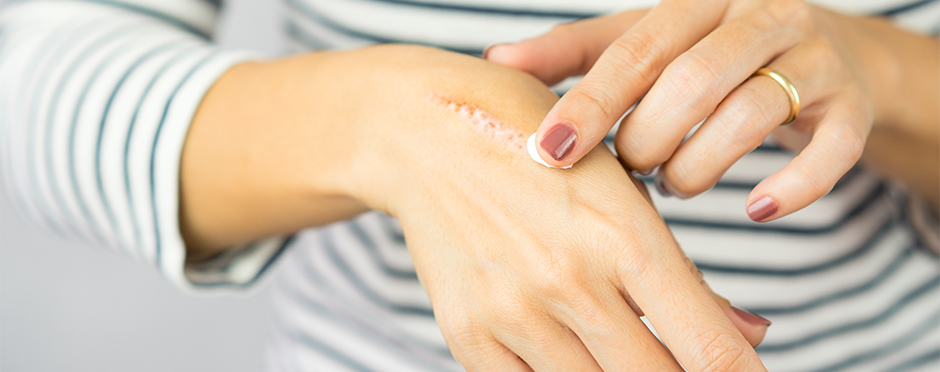
Scar Management: Tips & Tricks
Leave a CommentScarring is what allows the body to rapidly repair following an injury. This speedy tissue repair process protects the body from fluid loss and infection. However the new tissue is not quite as good as the original tissue. Scarring produces an excessive amount of connective tissue as a part of the reactive, inflammatory, and repairing process. The longer it takes a wound to heal, the more damage is caused, leaving a greater likelihood of an adherent noticeable scar.
For those that have had a hand injury or hand surgery, they often will have to deal with both the physical and emotional effects of scarring. Scarring has a purposeful physical and functional effect on the body.
A scar can physically make it harder to move if it is over or near a joint. Other factors that influence scarring are age, race, underlying medical conditions and genetic predispositions to scarring.
Hand surgeons are acutely aware of these effects, which has led to advancements in surgical procedures that are less invasive, such as using scopes to perform techniques that previously required open procedures. They also use specific suture techniques to decrease the likelihood of scarring.
If scars are not properly managed they can result in contracture (or shortening) of tissues and adhesions (where the scar tissue sticks to other important structures.) When scars initially form, the collagen is not in an organized pattern. Scar tissue can be influenced during the healing process in order to remodel and realign the new collagen fibers. Hand therapists employ a variety of scar remodeling techniques in order to allow tissues to move and to improve the appearance of the healing scar.
Scar management techniques are performed after the sutures have been removed or the wound is closed, and the scar is mature enough to tolerate these techniques.
Here are a few examples of some treatments you can perform on your own, with the approval of your physician or after instruction from a hand therapist.
- Scar massage: This helps to soften, flatten, and provide moisture and flexibility to the scar. It can help to decrease itching and sensitivity.
- Silicone scar sheeting: These can be found at online or at brick and mortar stores, in the over- the- counter pharmacy or in the first aide sections. They can be a bit pricey, but can be cleaned and re-used until they no longer stick to the scar. They allow for oxygen to still penetrate the incision, yet hold the moisture in, which prevents an over production of collagen. This will allow the scar to become flattened, less red and more closely match the surrounding tissue.
- Paper tape application: Research studies conducted by plastic surgeons have concluded that wearing paper tape over an incision may be as effective as silicone gel sheeting, and much less expensive. It supports the scar and prevents hypertrophic (raised) scarring. To do this at home, (after sutures are removed) cut a piece of tape is cut that is 2-4 inches longer than the wound. First, apply over normal skin, then directly over the wound to compress it. The tape should be changed daily and is continued for two or more months.
A hand therapist is the best person to help assist you with your stubborn scar! They have training in advanced techniques that can be used to treat scarring. Some of these examples are massage, a variety of modalities, stretching, compression techniques, and splinting. Each program is developed on a case by case bases and is made to meet the individual needs of each patient.
If you are struggling with scarring or an injury, know that an Athletico hand therapist is around the corner to help! To request an appointment, click the button below. Appointments are available both in-clinic and virtually through our Telehealth platform.
The Athletico blog is an educational resource written by Athletico employees. Athletico bloggers are licensed professionals who abide by the code of ethics outlined by their respective professional associations. The content published in blog posts represents the opinion of the individual author based on their expertise and experience. The content provided in this blog is for informational purposes only, does not constitute medical advice and should not be relied on for making personal health decisions.
